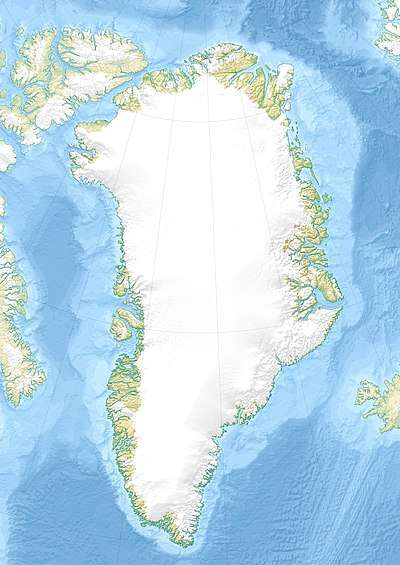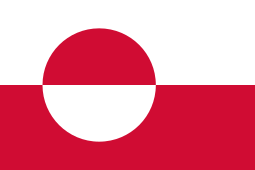Camp Century
Camp Century was an Arctic United States military scientific research base in Greenland.[1] situated 150 miles east of Thule Air Base. When built, Camp Century was publicized as a demonstration for affordable ice-cap military outposts and a base for scientific research[2][3].
| Camp Century | |
|---|---|
| Part of Project Iceworm | |
| Near Qaanaaq in Greenland | |
 Plan of base | |
 Camp Century | |
| Site information | |
| Owner | United States Army |
| Site history | |
| In use | 1959–1967 |
A preliminary camp for Project Iceworm whose end goal was to install a vast network of nuclear missiles launch sites that could survive a first strike. This was according to documents declassified in 1996.[4] The missiles were never fielded and necessary consent from the Danish Government to do so was never broached.
Powered by a nuclear reactor, the camp operated from 1959 until 1967. The base consisted of 21 tunnels with a total length of 9,800 feet (3.0 km). Project Iceworm was aborted after it was realized that the ice sheet was not as stable as originally assessed, and that the missile basing concept would not be feasible. The reactor was removed and Camp Century later abandoned. However, hazardous waste remains buried under the ice and has become an environmental concern.[5]
Scientific research
Ice core samples from Camp Century were used to create stable isotopes analyses used to develop climate models.[6][7][8] Analysis of soil contained in the samples suggests that the site was ice-free as recently as 400,000 years ago, indicating a much reduced Greenland ice sheet and therefore much higher sea levels.[9]
History
The "official purpose" of Camp Century, as explained by the United States Department of Defense to Danish officials in 1960, was to test various construction techniques under Arctic conditions, explore practical problems with a semi-mobile nuclear reactor, as well as supporting scientific experiments on the icecap.
Construction on the camp and the sub-glacial nuclear reactor began without explicit permission from the government of Denmark, leading to a political dilemma for Prime Minister H. C. Hansen.[10]
Design and Performance


Designed as an arctic subsurface camp and constructed by use of the cut-and-cover trenching technique. Layout of the camp consisted of a series of parallel main trenches in which buildings and other structures were housed. The camp had a design life span of 10 years with appropriate maintenance. It was permanently manned for 5 years and abandoned after 8 years.[11]
The trenches constructed in 1959 had compressed both vertically and horizontally that many had reached there design margins within 4 years. After that extensive snow trimming was required to maintain the trenches as the snow encroached on the buildings.[12]
The subsurface camp provided good protection from the elements and had modern bathroom, dining, and medical facilities.[13] The camp maintained a number of vehicles and had plenty of storage for fuel and food. The reactor provided plenty of power and proved it could be installed, operated, and removed in such a remote location. It powered the base for over 3 years but was shutdown due to the unexpected accelerated compression of the reactor trenches, in part due to the residual heat in the reactor area required to maintain the feed water pools.
The snow trimming required to maintain the trenches, and sewage disposal were both ongoing problems. The sewage sump was 150 feet from the nearest building and initially not vented. As a result, the odor of sewage became almost unbearable in the nearest quarters after the first year of operation. Subsequent venting of the sump reduced the odor but did not completely eliminate the condition. In 1962 core samples were taken in the areas near the sump and found that liquid wastes had horizontally permeated up to 170 feet (52 meters). Thus odor from the sump affected near by trenches with sleeping quarters and also accelerated trench deformation.[14]
In Oct 1965 the US Army concluded that subsurface ice camps are feasible and practical, that nuclear power offers significant advantages, and that the wealth of data and experience obtained from Camp Century will be of in estimable value in future designs.[15] However it is elevated structures on permanent snow fields that are in common use today.[16] No large subsurface ice camps are known to have been constructed after Camp Century was abandoned.
Residual environmental hazards
In 2016, a group of scientists evaluated the environmental impact and estimated that due to changing weather patterns over the next few decades, melt water could release the nuclear waste, 200,000 liters of diesel fuel[17], a nontrivial quantity of PCBs, and 24 million liters of untreated sewage into the environment as early as the year 2090.[18] Transition in ice sheet surface mass balance at Camp Century from net accumulation to net ablation is plausible within the next 75 years under one climate model. Another 44 to 88 years could expose the buried wastes between 2135 and 2179.[19]
Climate models differ. A Norwegian climate model suite (NorESM1) shows that increased snow fall is not overcome by increased melting. A Canadian model suite (CanESM2), gives an anticipated 2090 solid waste depth of 67 m, and between 44 and 88 years of persistent ablation that would be required to melt all overlying granular snow and expose wastes at the ice sheet surface. In either scenario, eventually contaminated and highly diluted melt water could be released at the coast. [20]
As of 2016, the majority of solid waste was likely buried at an approximate depth of 36 m (120 feet). Data suggests that in 2090 solid and liquid wastes will reside at depths of 67m (220ft) and 93 m (305ft), respectively. But surface and subsurface melt rates are uncertain.[21] Neither the US nor Denmark had taken responsibility for the future clean-up.
Further reading
- Colgan, Liam; Machguth, Horst; MacFerrin, Mike; Colgan, Jeff D.; van As, Dirk; MacGregor, Joseph A. (16 August 2016) [4 August 2016]. "The abandoned ice sheet base at Camp Century, Greenland, in a warming climate". Geophysical Research Letters. 43 (15): 8091–8096. doi:10.1002/2016GL069688. The original news story.
- Rosen, Julia (16 August 2016). "Mysterious, Ice-Buried Cold War Military Base May Be Unearthed by Climate Change". Science. doi:10.1126/science.aag0726. Retrieved 6 June 2017.
- Sima Sahar Zerehi (5 August 2016). "Climate change could expose Cold War–era Arctic military base". CBC News. Retrieved 27 November 2016.
- Doyle, Alister (17 October 2016). "Greenland calls for clean-up of toxic U.S. Cold War bases". Reuters. Retrieved 6 June 2017.
- 1963 documentary about building the camp, narrated by the project manager for the U.S. War Office on YouTube
- Thule Air Base/Camp Century information
- U.S. Army Corps of Engineers, Cold Regions Research and Engineering, Camp Century Evolution of Concept and History of Design Construction and Performance, Technical report 174
References
- Reed, John (April 6, 2012). "Inside the Army's Secret Cold War Ice Base". DefenseTech. Retrieved 3 October 2016.
- https://archive.org/details/TheU.S.ArmysTopSecretArcticCityUnderTheIceCampCenturyRestoredClassifiedFilm
- "Arctic City Under the Ice! "Camp Century" YouTube".
- Petersen, Nikolaj (17 Dec 2007). "THE ICEMAN THAT NEVER CAME". Scandinavian Journal of History Volume 33, 2008 - Issue 1. Retrieved 15 Aug 2020.
- "The Nuclear City Lost Under Ice - Camp Century Melting ice sheet could release frozen Cold War-era waste". July 20, 2020. Retrieved Aug 9, 2020.
- William Sweet (February 2008). Kicking the Carbon Habit: Global Warming and the Case for Renewable and Nuclear Energy. Columbia University Press. p. 72. ISBN 978-0-231-13711-9.
- Chester C. Langway; Hans Oeschger; W. Dansgaard (1985). Greenland Ice Core: Geophysics, Geochemistry, and the Environment. American Geophysical Union. p. 74. ISBN 978-0-87590-057-5.
- Thomas M. Cronin (5 September 1999). Principles of Paleoclimatology. Columbia University Press. p. 415. ISBN 978-0-231-50304-4.
- Voosen, Paul (2019-11-01). "Mud in storied ice core hints at a thawed Greenland". Science. 366 (6465): 556–557. doi:10.1126/science.366.6465.556. ISSN 0036-8075. PMID 31672870.
- Nielsen, Kristian Hvidtfelt (December 19, 2017). "How the US built a mysterious military camp under the Greenland ice sheet". Translated by Jex, Catherine. ScienceNordic. Retrieved December 21, 2017.
- Camp Century Evolution of Concept and History of Design Construction and Performance, Technical report 174 (PDF), p. 27
- Camp Century Evolution of Concept and History of Design Construction and Performance, Technical report 174 (PDF), p. 41
- https://archive.org/details/TheU.S.ArmysTopSecretArcticCityUnderTheIceCampCenturyRestoredClassifiedFilm
- Camp Century Evolution of Concept and History of Design Construction and Performance, Technical report 174 (PDF), p. 43
- Camp Century Evolution of Concept and History of Design Construction and Performance, Technical report 174 (PDF), p. 65
- https://www.geosummit.org/sites/default/files/docs/Summit-Station_ERDC-CRREL_SR-14-2.pdf
- Colgan, Liam; Machguth, Horst; MacFerrin, Mike; Colgan, Jeff D.; van As, Dirk; MacGregor, Joseph A. (16 August 2016) [4 August 2016]. "The abandoned ice sheet base at Camp Century, Greenland, in a warming climate". Geophysical Research Letters. 43 (15): 8091–8096. doi:10.1002/2016GL069688.
- "SciShow: The Nuclear City Lost Under Ice - Camp Century Melting ice sheet could release frozen Cold War-era waste". July 20, 2020. Retrieved Aug 9, 2020.
- Colgan, Liam; Machguth, Horst; MacFerrin, Mike; Colgan, Jeff D.; van As, Dirk; MacGregor, Joseph A. (16 August 2016) [4 August 2016]. "The abandoned ice sheet base at Camp Century, Greenland, in a warming climate". Geophysical Research Letters. 43 (15): 8091–8096. doi:10.1002/2016GL069688.
- Colgan, Liam; Machguth, Horst; MacFerrin, Mike; Colgan, Jeff D.; van As, Dirk; MacGregor, Joseph A. (16 August 2016) [4 August 2016]. "The abandoned ice sheet base at Camp Century, Greenland, in a warming climate". Geophysical Research Letters. 43 (15): 8091–8096. doi:10.1002/2016GL069688.
- Colgan, Liam; Machguth, Horst; MacFerrin, Mike; Colgan, Jeff D.; van As, Dirk; MacGregor, Joseph A. (16 August 2016) [4 August 2016]. "The abandoned ice sheet base at Camp Century, Greenland, in a warming climate". Geophysical Research Letters. 43 (15): 8091–8096. doi:10.1002/2016GL069688.
